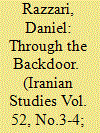|
|
|
Sort Order |
|
|
|
Items / Page
|
|
|
|
|
|
|
| Srl | Item |
| 1 |
ID:
118907


|
|
|
|
|
| Publication |
2012.
|
| Summary/Abstract |
The English East India Company established a factory on the island of Condore, off the coast of southern Vietnam, in 1702 as part of its plan to maintain a settlement to direct shipping activities between trading ports in China and Southeast Asia and India. For three years, the settlement thrived and was an important part of the China trade network, especially as a stopping point for ships plying the China route. The island settlement also carried out trading activities with neighbouring ports along the Indochina coast and the Malay Archipelago. The setting up of the factory, however, coincided with the emergence of the new entity of southern Vietnam under the Nguy?n family who were expanding their power-base to the south. In the process, the Nguy?n had already subdued the Chams and were coming face-to-face with the Khmers when the English factory was established. This paper will trace the English venture on Condore Island and the reaction of the Nguy?n ruler towards this venture which culminated with the destruction of the factory in 1705. This paper will attempt to explore the following questions: the shifting importance of the islands in the Nguy?n's security and foreign relations vis-à-vis the English factory, and will also investigate the circumstances that brought about the massacre and destruction of the English factory on Pulo Condore-a historical event that has not been properly explained thus far.
|
|
|
|
|
|
|
|
|
|
|
|
|
|
|
|
| 2 |
ID:
168975


|
|
|
|
|
| Summary/Abstract |
In 1616, the English East India Company expanded its trade into Safavid Iran. The chief merchants in India hoped to acquire a significant share of the Iranian silk trade. After several difficult years in India, the English traders in Surat felt pressure to establish a solid foundation in Iran where they could redirect Iranian silk through Iran’s southern ports and onto Company ships for Europe. Despite Robert Sherley’s promise of wealth and a prosperous market for English cloth, many in the English camp, predominantly Sir Thomas Roe, objected to the silk trade on grounds that it was generally a risky venture. But several leading merchants dismissed Roe’s concerns and pursued the trade without his approval. After early indications that the venture had potential for success, the English silk trade quickly began to falter and finally ceased to exist by 1640. Although its demise was once described as the Company’s failure to produce a substantial quantity of purchasing power—eastern goods, precious metals, and English commodities—this paper explores an alternative explanation that suggests the Company’s failure in Iran was not exclusively the consequence of poor economics.
|
|
|
|
|
|
|
|
|
|
|
|
|
|
|
|
| 3 |
ID:
167936


|
|
|
|
|
| Summary/Abstract |
Although historians have long recognized the important role that Indians played in the English East India Company's operations, the focus has usually been on the mechanics of direct rule in ‘British’ India. Yet, the expertise of Indian cultural intermediaries was arguably even more important, as well as more contested, in the context of the Company's growing political influence over nominally independent Indian kingdoms. This article examines the relationships between the East India Company's political representatives (Residents) and their Indian secretaries (munshis) at Indian royal courts during a period of dramatic imperial expansion, from 1798 to 1818. The article considers how these relationships were conceptualized and debated by British officials, and reflects on the practical consequences of these relationships for the munshis involved. The tensions surrounding the role of the munshi in Residency business exemplify some of the practical dilemmas posed by the developing system of indirect rule in India, where the Resident had to decide how much responsibility to delegate to Indian experts better versed in courtly norms and practices, while at the same time maintaining his own image of authority and control. Although the Resident–munshi relationship was in many respects mutually beneficial, these relationships nevertheless spawned anxieties about transparency and accountability within the Company itself, as well as exciting resentments at court. Both Residents and munshis were required to negotiate between two political and institutional cultures, but it was the munshi who seems to have borne the brunt of the risks associated with this intermediary position.
|
|
|
|
|
|
|
|
|
|
|
|
|
|
|
|
|
|
|
|
|